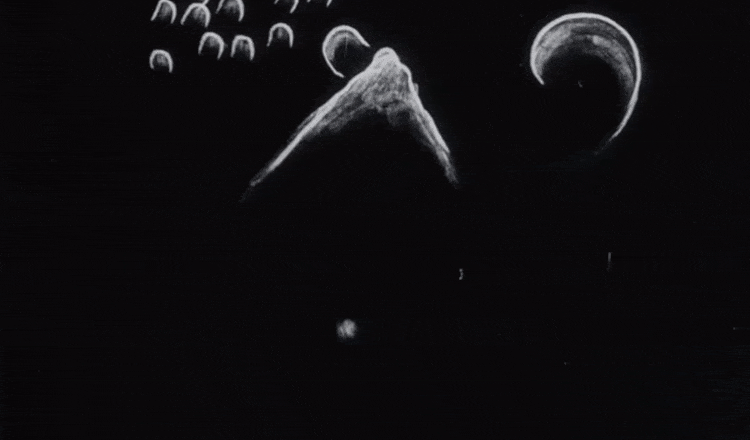Get In Sync With Oskar Fischinger, a 20th-Century Pioneer of Experimental Animation

During the early 20th century, the animation world was dominated by Walt Disney and his ever-popular cartoon character, Mickey Mouse. But while Disney was developing a whole host of anthropomorphized animals, there was one avant-garde filmmaker who was doing the exact opposite.
German animator Oskar Fischinger gave life to abstract shapes by exploring the relationship between sound and image. He created an influential series of experimental short films featuring circles, squares, and lines that appeared to dance to music.
Who was Oskar Fischinger?
View this post on Instagram
Fischinger was a German-American animator, filmmaker, and painter who is best known for creating abstract animations that accompany music. Long before computer graphics, Fischinger spent months—and even years—meticulously hand-painting on glass and photographing each frame. He would then arrange them together to perfectly sync with musical compositions. The prolific artist made over 50 short films and painted around 800 canvases.
Early Career in Filmmaking
Born in 1900 Gelhausen, Germany, Fischinger trained as a musician and an architect before discovering film. In 1920, he was introduced to film critic Bernhard Diebold, who was impressed with Fischinger’s abstract sketches and suggested that he get into filmmaking. The following year, Fischinger attended the first public screening of Walther Ruttmann’s Light Play Opus I. Fischinger was so inspired by the film that he decided to dedicate his time and creativity to “absolute cinema,” a non-narrative style of experimental film that allowed Fischinger to merge his love of music and art.
Fischinger moved to Munich and began a full-time career in filmmaking. While he was working on his visual experiments, he supported himself financially by forming a company that produced satirical cartoons. For his earliest abstract animations, such as Wax Experiments and Spirals, Fischinger created complex, hypnotizing movements using unconventional methods. Wax Experiments was made using his self-made machine he called a “Wax Slicing Machine.” It synchronized a vertical slicer with a movie camera's shutter, capturing sequential images of cross-sections through a length of molded wax and clay.
In June 1927, Fischinger traveled from Munich to Berlin by foot to escape his financial difficulties. He recorded his journey in a series of single-frame photos that he then made into a short film. Walking from Munich to Berlin greatly influenced later artists who explored visual diaries in film.
Working in Berlin and Fleeing Nazi Germany
In 1929, Fischinger was hired to create special effects—rockets, stars, and outer space landscapes—for the film Woman on the Moon directed by Fritz Lang. After breaking an ankle on set, however, Fischinger was forced to create everything from the hospital. He began drawing charcoal animations on paper, leading to his Studies series.
Fischinger’s Studies series featured hand-drawn motifs and geometric shapes that moved in synchronization to music. The short films were popular around the world, but the rise of Nazism led them to be labeled as “degenerate art.” During this time, the Nazis hated any art that was non-representational. Along with Fischinger, abstract artists such as Paul Klee and Wassily Kandinsky were written off as unsuccessful creatives.
But that didn't stop Fischinger from making films. The era also saw the invention of the Gasparcolor process, allowing him to create animations in color. Fischinger produced a film called Circles (1933-1934), which was used as an advertising film. He also produced a second film in color, Composition in Blue, that he submitted to foreign festivals without an official permit from Nazi authorities. Shortly after its production, Fischinger fled to Hollywood in a bid to escape persecution and to pursue new opportunities.
Life and Work in the U.S.
Fischinger was drawn to Hollywood in 1936 with the promise of a job at Paramount Studios. He began working on a color film that was originally titled Radio Dynamics (known today as Allegretto), which was planned to be included in the feature film, The Big Broadcast of 1937 (1936).
Unknown to Fischinger, however, Paramount had planned to release the film in black and white, and the studio was not able to test Fischinger’s color film. Fischinger requested to be let out of the contract and left his position at Paramount Studios. Several years later, he bought back the film using a grant from the Museum of Non-Objective Painting (later known as The Guggenheim). Fischinger re-painted the cells to suit his original colorful vision, and Allegretto became one of the most successful films to visualize music in history.
Most of Fischinger's filmmaking attempts in the U.S. failed in some way (or at least his attempts to earn money or recognition). In 1937, he composed an Optical Poem to accompany Franz Liszt’s Second Hungarian Rhapsody for MGM, however, he received no profits for his work. He also designed an abstract animation for Disney’s 1940’s hit, Fantasia, but quit without credit because Disney altered his designs to be more representational.
After numerous struggles to make it in Hollywood, Fischinger began pursuing oil painting. He combined his passion for painting with animation in his 1947 film, Motion Painting No. 1. For this animation, Fischinger captured the mesmerizing process of painting by photographing every brushstroke as it was applied to the canvas. The film ended up winning the Grand Prix at the Brussels International Experimental Film Competition in 1949 and is still one of his most famous works. Fischinger died in Los Angeles in 1967, but his legacy lives on through his groundbreaking work.
Related Articles:
5 Pioneers of Early Animation Who Influenced the Future of Film
8 Charming Stop Motion Animations That Bring Inanimate Objects to Life
Studio Ghibli: Everything You Need To Know About Legendary Japanese Animation House
9 Abstract Artists Who Changed the Way We Look at Painting
READ: Get In Sync With Oskar Fischinger, a 20th-Century Pioneer of Experimental Animation


0 Commentaires